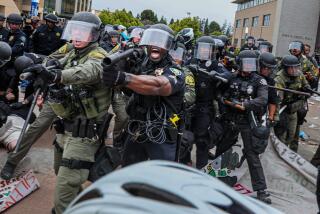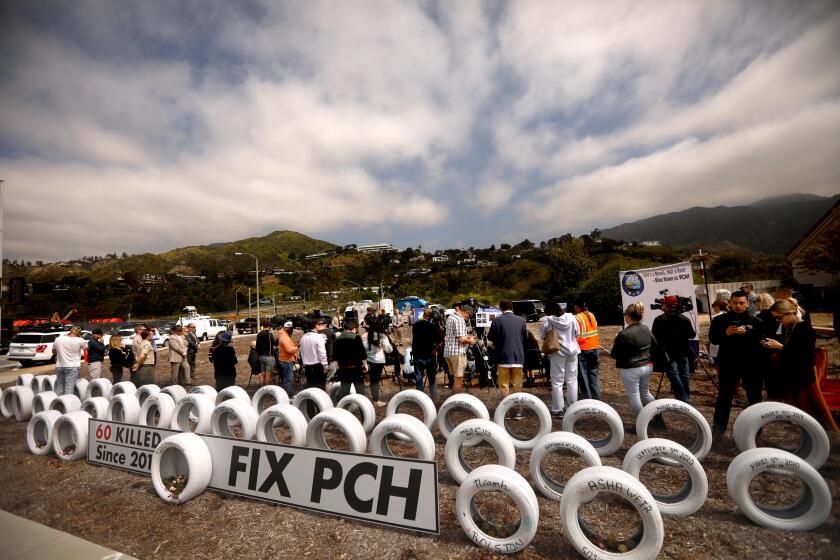Dear Street Smart:Please tell me who the...
Dear Street Smart:
Please tell me who the rocket scientists are who decided to change Fairview Street in Santa Ana to a four-lane street. What in the heck were they thinking?
Fairview was a six-lane street (three lanes in each direction) from the Costa Mesa Freeway up to the Santa Ana River crossing. Now it has only two lanes on each side, going north from 1st Street.
Prior to this brilliant change, there was a little bit of congestion. Now there’s a parking lot. What once took 10 minutes to get through now takes half an hour.
Their plan (whatever it was) backfired! Please tell them to give us back our lanes.
Ross Greco
Fullerton
You can relax. You will get your lanes back in November or December.
City and county traffic engineers together decided to convert Fairview’s outer traffic lanes to temporary bike lanes, said Albert Mesch, associate traffic engineer for Santa Ana. The decision was approved by Santa Ana’s City Council and city manager, he said.
The move was done to accommodate bicyclists who cannot use the Santa Ana River bike trail during reconstruction of the riverbed, Mesch said. The U.S. Army Corps of Engineers, which is doing the work, determined it would be unsafe for cyclists to use the bike trails during construction.
The riverbed project extends from the Pacific Ocean to the city of Orange and goes through several cities, Mesch said. Each city involved and the county, which owns the river, came up with different alternatives for the cyclists who use the river bike trail, he said.
Santa Ana and the county thought it was best to create a bike route traveling up Newhope Street, then on 1st Street between Newhope and Fairview and then up and down Fairview between 1st and the Santa Ana River, Mesch said.
Dear Street Smart:
The median strip landscaping on La Palma Avenue just west of the intersection at Imperial Highway in Anaheim Hills causes a hazard for anyone wishing to make a left-turn exit onto La Palma from the northwest corner shopping center and theater complex.
The taller shrubbery on the median strip obstructs any view of approaching eastbound La Palma traffic. These particular shrubs are surrounded by low-lying shrubs of a different variety that do not block the view at all.
I’d like to see the taller shrubs either removed entirely or else spaced at intervals to allow essentially clear viewing of oncoming traffic by left-turning motorists from this busy shopping center.
Personally, I’m tired of having to decide whether to turn left and risk colliding with an unseen vehicle or turn right and travel several miles out of my way to return home.
Lynette M. Smith
Yorba Linda
Ask, and ye shall receive. On the strength of your letter, the Anaheim Parks and Recreation Department late last week had the oleanders on La Palma trimmed back to the standard 18 inches, said Jack Kudron, parks superintendent for Anaheim.
Private landscape contractors do the shrub trimming as needed all over the city, Kudron said. A city landscape inspector spends much of his time ensuring that the contractors do their jobs, but letters like yours are always welcome, he said.
Kudron also said his department is considering removing the oleanders and replacing them with a lower level shrub that wouldn’t require pruning.
Dear Street Smart:
Since there are exits for Alameda Street on both the San Diego and Riverside freeways, why are they lacking on the Glenn Anderson (105) Freeway? Why does such a major street lack even mention on our newest freeway?
On the westbound Glenn Anderson, there is not even a sign saying something to the effect of “Alameda Street, use next exit.” I do not know whether there is such signage in the eastbound direction.
If it is Caltrans’ intention not to construct an interchange at Alameda, then I recommend signs be erected before the Long Beach Boulevard and Wilmington Avenue exits on the westbound Glenn Anderson Freeway and signs before the Wilmington Avenue exit on the eastbound side.
Jim Rueff
Cypress
Back in 1972, The state Supreme Court, ruling on challenges to the Glenn Anderson Freeway brought by environmental groups, issued a decree in 1972 that limited the number of streets that could intersect with the freeway, said Rick Holland, a Caltrans spokesman in Los Angeles. Budget constraints and environmental concerns were cited in the decree that allowed for only 10 street intersections, he said. Western Avenue and Alameda Street were thus eliminated.
Holland said Caltrans does not plan to erect extra signs on the freeway to alert motorists of the best exits to take to get to Alameda Avenue. Too many signs would be a safety hazard, he said.
More to Read
Start your day right
Sign up for Essential California for news, features and recommendations from the L.A. Times and beyond in your inbox six days a week.
You may occasionally receive promotional content from the Los Angeles Times.






